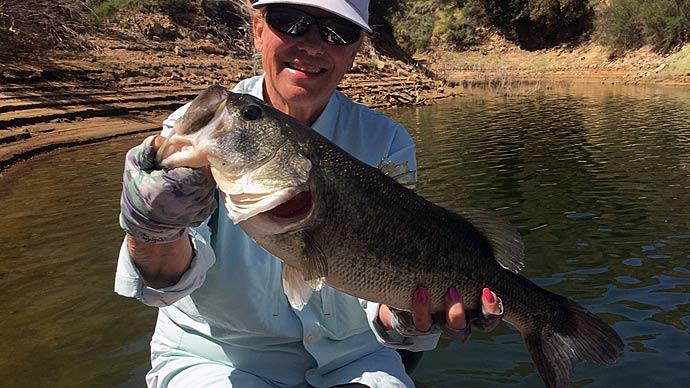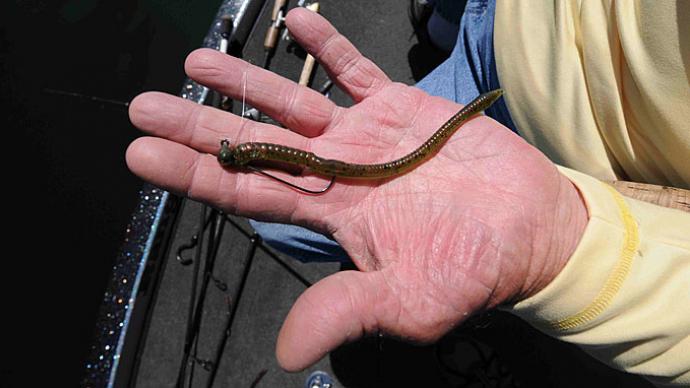
Not a whole lot of shaking goes on when Marty Robinson makes a shaky head presentation.
As a matter of fact, it’s kind of a drag when Robinson uses a shaky head.
A shaky jighead combined with a soft plastic lure is one of Robinson’s favorite tactics for finesse fishing. “The number one thing about it is it’s what I call a non-intrusive bait,” Robinson says. “It is small, slender, and a finesse-type bait. It is not intrusive to a bass, so it doesn’t trigger his defense mechanisms when you fish it around the bass.”
The Major League Fishing (MLF) pro considers the lure an easy snack for picky bass. “When they are not in a feeding mode, it really appeals to them because of the size of the bait and its slender profile,” Robinson says. “That seems to appeal to them when they are in a negative mode.”
The shaky head appeals to Robinson because the finesse tactic is effective year-round. “You can catch bass on it in 40-degree water up to 100-degree water,” he says. “That is probably the best thing about it. “
Although the shaky head will catch fish in any conditions, it shines best when employed in clear, shallow water during post-frontal conditions. Robinson also considers the shaky head one of the best solutions he can depend on when encountering heavy fishing pressure.
Robinson’s favorite shaky head setup consists of a green pumpkin 3/16 –ounce Buckeye Lures Spot Remover jighead paired with a green pumpkin/green flake Zoom Trick Worm. “The Trick Worm has a unique way it sits in the water,” Robinson says. “With the flat top of the Buckeye Lures Spot Remover head, the worm sits straight up. The tail of the Trick Worm is fatter than the rest of the body of the worm, so the tail kind of floats up, which is the most appealing thing about that Trick Worm.”
When fishing bodies of water containing larger bass, Robinson combines a Zoom Magnum Trick worm with a 3/16- or 1/4-ounce Buckeye Magnum Spot Remover jighead. “The Magnum Trick Worm is a good finesse bait for big bass,” he says.
The South Carolina pro will also combine the Magnum Spot Remover jighead with soft plastics such as a Zoom Ultra Vibe Speed Craw or a Senko. A 1/4- or 5/16-ounce jighead works best for these soft plastics. Robinson usually employs these shaky head combos when he wants to present a different-looking bait to pressured bass.

The shaky head Trick Worm is ideal for throwing to bass burrowed in cover. “It is perfect for fishing in brush,” Robinson says. “A lot of times, bass get into brush piles when they are inactive. They sit there and don’t want to come out and chase a bait. The whole deal with that shaky head is when you come over a limb, you often trigger a reaction strike by bumping it over one of those limbs.” Robinson also likes throwing the shaky head around stumps, laydowns, docks, and rocks, but he never uses it in thick grass. He opts for a drop-shot rig in grass because he can better keep his bait off the bottom and above the weeds.
Robinson has seen other anglers shake a shaky head all the way to the boat and catch bass, but he opts for a different presentation despite the rig’s name. “I drag it a lot,” Robinson says. He suggests aggressive bass will eat the shaky head when it’s shaken and retrieved slowly, but after a cold front, he prefers dragging the Trick Worm along the bottom throughout most of his presentation. After each short drag, he will twitch the lure several times to trigger a strike from any bass following the shaky head.
The tournament veteran retrieves his other shaky head soft plastics similarly. “I will hop the Speed Craw a little bit more to try and mimic a crawfish,” Robinson says.
Robinson’s gear for shaky head fishing consists of a 7-foot, medium-power Castaway Invicta II Drop Shot Special spinning rod and a 2000- or 2500-size spinning reel filled with 15-pound P-Line TCB 8 8-Carrier braided line. He attaches a 10-foot leader of 8-pound P-Line Tactical Fluorocarbon for most situations, although he will scale down to 6-pound fluorocarbon when fishing pressure is heavy and the bite is tough. When he fishes the shaky head in heavy cover, Robinson opts for a 7-foot, moderate fast action Castaway Invicta II casting rod and Team Lew’s Custom Pro Speed Spool 6.8:1 gear ratio baitcast reel spooled with 10- or 12-pound P-Line fluorocarbon.
When Robinson sets the hook on a shaky head, the bite depends on the type of cover he is fishing. If Robinson gets a bite while targeting rocks or sparse cover, he waits a while before setting the hook. “I try to let them get it pretty good,” he says. “They never spit that thing out on me, so I never worry about setting the hook too slow.” However, he sets the hook quicker when working the shaky head through brush because he wants to prevent the fish from swimming around in the cover and getting hung up after the hook set.
The shaky head produces good numbers of bass for Robinson, but he also believes the tactic catches heavyweight bass just as quickly as any big bass lure under the right conditions.
BassResource may receive a portion of revenues if you make a purchase using a link above.




